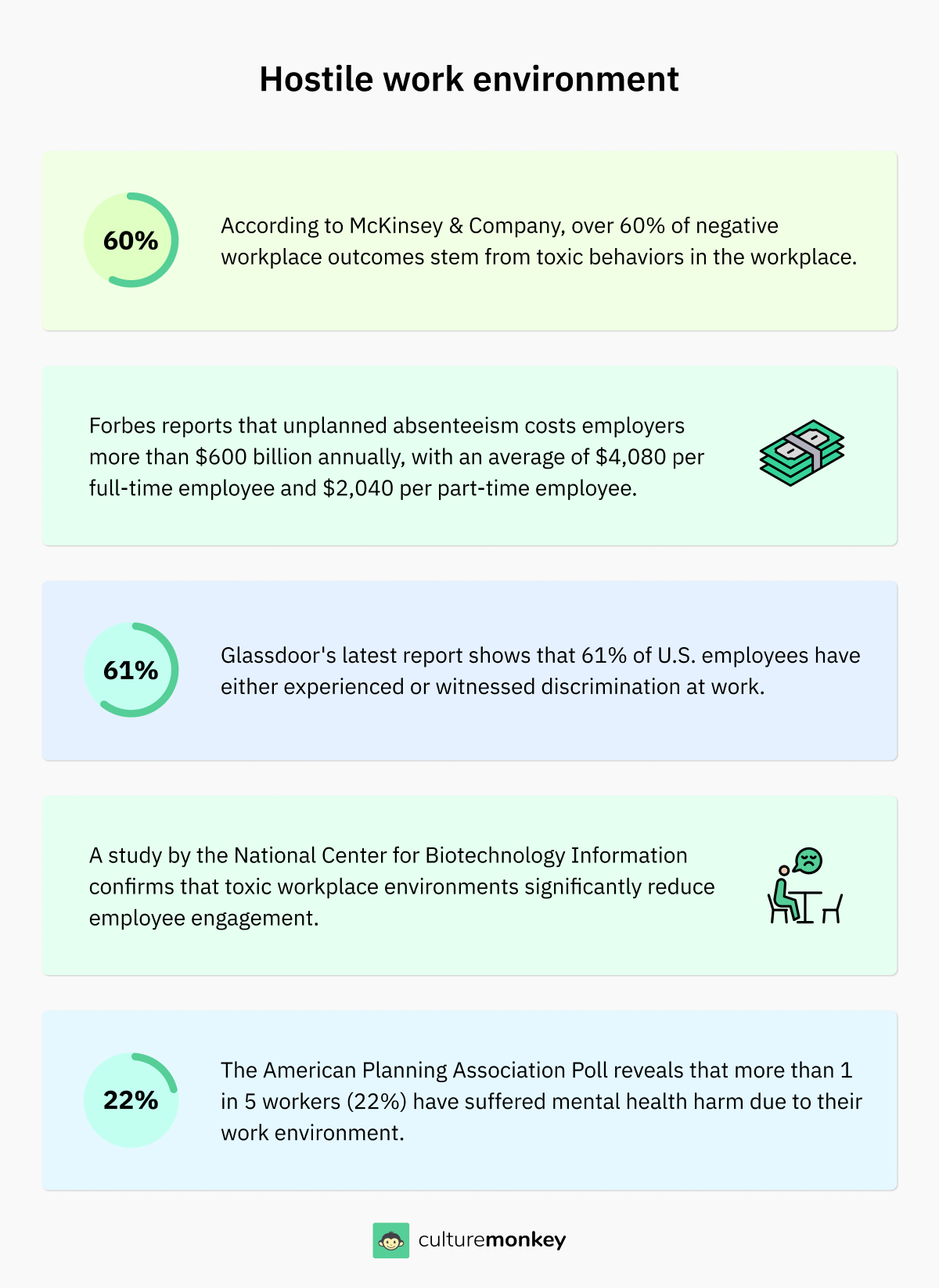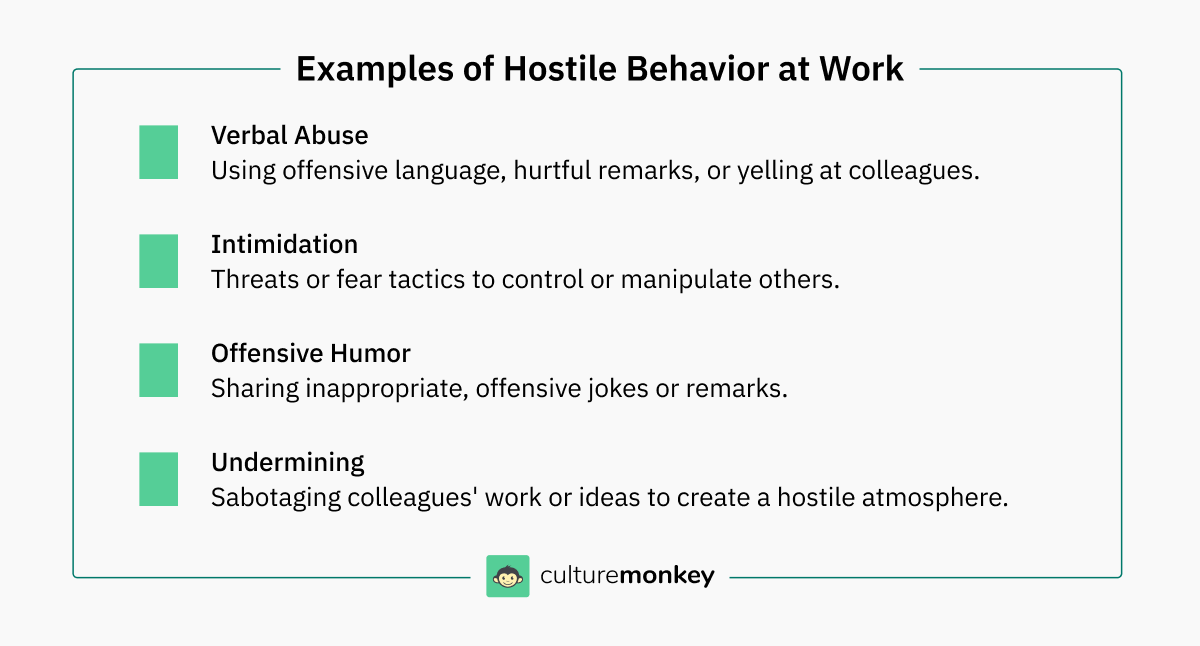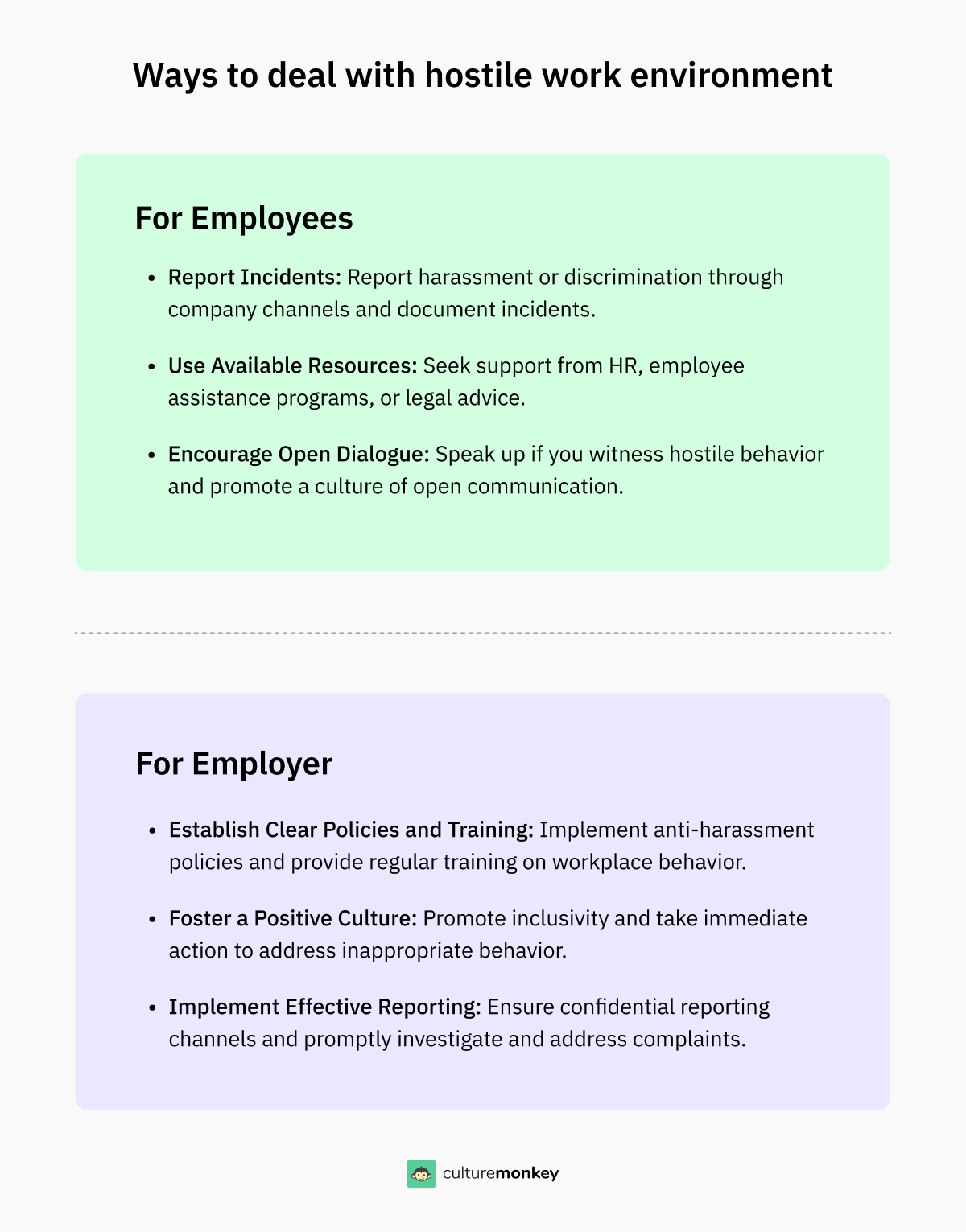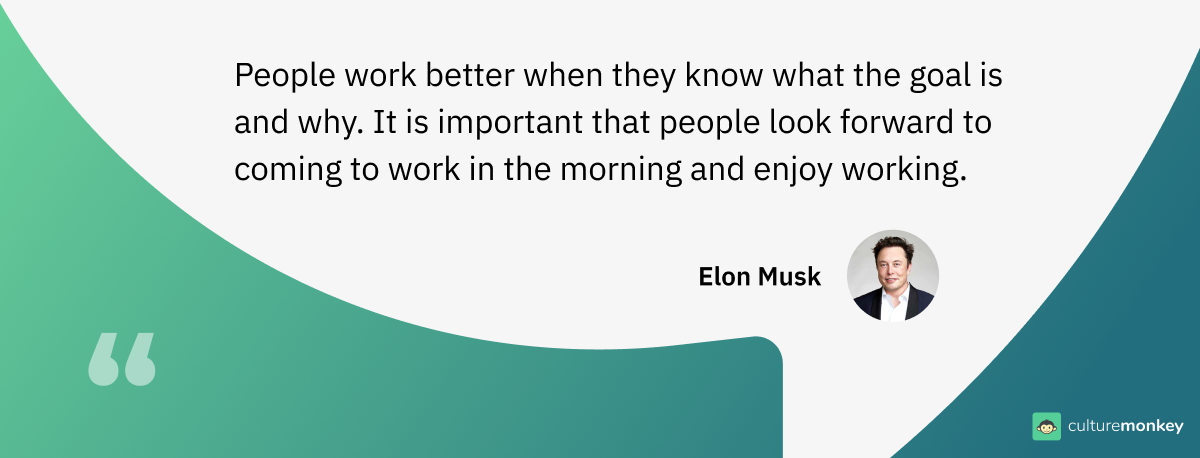Hostile work environment: The red flags and how to tackle them

Remember those childhood road trips where one sibling hogged all the snacks, another kept poking you for no reason, and the car AC barely worked? You couldn’t escape, tensions ran high, and by the third hour, even silence felt loud. No one said it, but everyone felt it—trapped, irritated, and one wrong word away from meltdown.
Now imagine that same pressure simmering every day at work.
That’s the silent power of a hostile work environment—it creeps in subtly, chips away at morale, and if left unchecked, turns a functioning team into a stressed-out, disengaged mess. As a leader, you may not always see it coming—but once you feel it, it’s already affecting your people.
In this blog, we’ll break down what it really means, why it forms, and what you can do to recognize (and fix) the signs before they escalate.
Blog Highlights


What is a hostile work environment?
A hostile work environment is a workplace where repeated behavior—such as harassment, discrimination, or bullying—creates an intimidating, offensive, or toxic atmosphere. According to the U.S. Equal Employment Opportunity Commission (EEOC), it becomes illegal when this behavior is severe or pervasive enough to interfere with an employee’s ability to work.
This hostility can come from coworkers, managers, or even clients and often includes verbal abuse, derogatory remarks, or discriminatory actions. In U.S. labor law, such conditions may qualify as unlawful if based on protected characteristics like race, gender, age, or disability.
In short, it’s an environment where people feel unsafe, stressed, or unwelcome—making it hard to thrive or even function. Left unchecked, it can lead to high turnover, poor performance, and serious legal consequences. Recognizing the signs early is key to protecting both your team and your company culture.
What qualifies as a hostile work environment?
Understanding the signs of a toxic workplace is critical to protecting employee well-being. Below are hostile work environment examples that help answer common questions and offer clear examples of hostile work environment behavior.
- Severe or pervasive behavior: The behavior must be serious or happen frequently enough to create an intimidating, offensive, or abusive work atmosphere.
- EEOC definition: The U.S. EEOC defines it as conduct that interferes with an employee’s ability to perform their job effectively.
- Employer responsibility: Employers must address complaints and take action to prevent further issues.
- Reporting: Employees should report the behavior, follow internal procedures, and seek legal advice if necessary.
- Harassment or discrimination: Unwelcome conduct based on protected characteristics like race, gender, age, religion, or disability.
- Prevention: Regular diversity training, clear reporting channels, anti-harassment policies, and promoting mutual respect are key to preventing hostile environments.
- Unwelcome physical conduct: Physical actions, such as unwanted touching, blocking someone's movement, or threatening gestures, can contribute to hostile working conditions.
- Retaliation: Hostile environments may develop when employees face negative consequences, such as demotion or ostracism, after reporting harassment or discrimination.
- Verbal abuse: Consistent use of offensive language, insults, or derogatory remarks towards an employee can create a hostile environment.
- Intimidation and threats: Behaviors that instill fear, such as threats of job loss or physical harm, contribute to a hostile work setting.
- Microaggressions: Subtle, often unintentional acts of bias or discrimination, such as backhanded compliments or dismissive comments, can contribute to a toxic work culture over time.
- Unreasonable work demands: Singling out an employee for excessive or impossible workloads or assigning demeaning tasks based on protected characteristics can create a hostile environment.
- Undermining work performance: Sabotaging or deliberately hindering an employee's ability to complete tasks or meet objectives based on bias or discrimination qualifies as creating a hostile environment.
- Workplace sabotage: Intentionally damaging, withholding, or interfering with tools or resources needed for an employee to perform their job can contribute to a hostile environment.
- Failure to act: If employers consistently fail to address or investigate complaints of hostile work environment harassment or discrimination, this neglect can contribute to a perpetually hostile work environment.
- Spreading malicious rumors: Workplace gossip that targets specific employees with false or harmful information can foster a hostile work culture and create long-term damage to professional reputations.
- Exclusion from opportunities: Consistently excluding certain employees from key projects, promotions, or professional development due to bias can contribute to a hostile workplace, making individuals feel undervalued and alienated.
- Inconsistent policy enforcement – Applying rules or disciplinary actions unfairly, such as punishing some employees more harshly than others for the same behavior, fosters resentment and contributes to a hostile work environment.
- Lack of managerial accountability – When leadership ignores or participates in toxic behavior, employees may feel powerless to report issues, leading to a culture where hostility is normalized and unaddressed.
- Emotional manipulation – Gaslighting, guilt-tripping, or other forms of psychological coercion that make employees doubt their own experiences or feel pressured to accept mistreatment contribute to a toxic and abusive workplace atmosphere.
What is not considered a hostile work environment?

Not all workplace stress or conflict qualifies as a hostile work environment. To clarify the hostile environment meaning, here are situations that fall outside the definition of a hostile work environment.
- Personality conflicts: Personal disagreements not involving harassment or discrimination based on protected characteristics.
- Performance management: Constructive feedback, evaluations, or managerial actions addressing performance issues.
- Work-related stress: Stress from workplace demands or responsibilities, even if uncomfortable, is not automatically hostile.
- Supervisory decisions: Routine decisions like scheduling or task assignments, even if they cause discontent.
- Job expectations: Meeting performance standards or job requirements, even under pressure.
- Work disputes: Work-related conflicts or grievances not based on protected characteristics.
- Team disagreements: Disagreements over work matters without discriminatory actions.
- Ethical disagreements: Differing opinions on ethical issues without resulting in discrimination.
- Unequal workload: Uneven workload distribution without discriminatory intent.
- Disciplinary actions: Legitimate disciplinary measures aligned with company policy.
- Workplace changes: Job role changes or restructuring for business reasons.
The importance of creating a psychologically safe workplace
A psychologically safe workplace isn’t a luxury—it’s the foundation for trust, teamwork, and preventing the kind of toxicity that turns any job into a daily battle.
- Boosts open communication: In psychologically safe environments, employees speak honestly without fear of backlash—something you rarely see in coworker hostile work environment situations where silence becomes survival.
- Reduces turnover and burnout: Teams with high psychological safety report lower stress and attrition, unlike those facing ongoing hostile work environment examples like bullying, gaslighting, or exclusion.
- Encourages innovation and risk-taking: When people aren’t worried about ridicule, they take smart risks. In contrast, one of the examples of hostile work environment is punishing failure, which kills creativity.
- Strengthens team trust: Teams thrive when members feel protected—not targeted. Trust is the opposite of what constitutes a hostile work environment, where fear and favoritism rule.
- Helps identify issues early: A safe space lets employees raise red flags before situations escalate into one of the three types of hostile work environment defined by law.
- Supports personal growth: Knowing how to deal with a hostile work environment starts with prevention. Safety allows people to grow, while learning how to handle a hostile work environment or how to survive in a hostile work environment should be the last resort—not the norm.
Signs of a hostile work environment

Wondering if your workplace might be toxic or even legally hostile? Below are common signs of a hostile work environment, ranging from overt harassment to subtle systemic patterns that damage morale and safety.
- Harassment and discrimination: Persistent, unwelcome comments or actions related to protected characteristics like race, gender, or age.
- Intimidation and threats: Bullying or aggressive behavior that creates fear or unease.
- Offensive behavior: Derogatory language, gestures, or actions targeting individuals or groups.
- Isolation and exclusion: Deliberate exclusion from work activities based on protected characteristics in isolated incidents.
- Retaliation: Negative consequences for reporting harassment or discrimination.
- Pervasive negativity: A hostile atmosphere that affects the overall work environment.
- Unaddressed complaints: Failure to address employee concerns about the environment.
- Impact on performance: Decreased productivity due to the hostile atmosphere.
- High turnover: Frequent departures, especially from specific groups.
- Subtle microaggressions: Indirect acts of bias, like backhanded compliments.
- Cliquish behavior: Exclusive groups that marginalize others.
- Inconsistent policy enforcement: Unequal application of harassment or discrimination policies.
- Health effects: Emotional or physical health impacts like stress and anxiety.
- Excessive workload: Unfair workload targeting individuals based on protected characteristics.
- Undermining achievements: Efforts to downplay the accomplishments of certain groups.
- Unjustified scrutiny: Unfair criticism of work based on protected characteristics.
- Favoritism: Preferential treatment based on personal relationships, not merit.
Hostile work environment vs workplace discrimination
Here’s a table highlighting the differences between hostile work environment and workplace discrimination across seven key points:
| Criteria | Hostile work environment | Workplace discrimination |
|---|---|---|
| Definition | Unwelcome behavior creates an offensive, intimidating, or abusive atmosphere. | Unfair treatment of employees based on protected characteristics. |
| Focus | Primarily on creating a toxic atmosphere for the employee. | Focuses on unequal treatment or denial of opportunities. |
| Behavior | Includes harassment, verbal abuse, intimidation, and offensive jokes. | Involves bias in hiring, promotions, pay, or other employment decisions. |
| Protected characteristics | May or may not be based on protected characteristics like race, gender, etc. | Directly based on protected characteristics (race, gender, religion, etc.). |
| Examples | Sexual harassment, bullying, and persistent offensive remarks. | Unequal pay for the same work, denial of promotions based on gender or race. |
| Employer liability | Employers are liable if they fail to prevent or address the hostile environment. | Employers are liable if they engage in or allow discriminatory practices. |
| Legal framework | Addressed under hostile work environment laws and harassment statutes. | Governed by anti-discrimination laws like Title VII of the Civil Rights Act. |
Impact of hostile work environment: Statistics

A hostile workplace doesn’t just affect individual employees—it drags down morale, productivity, and profit. Below are data-backed insights into how toxic environments impact people and businesses:
- Decreased employee morale: Hostile workplace erode morale, leading to fear, frustration, and demotivation. Over 60% of negative workplace outcomes are caused by toxic behavior, according to McKinsey & Company.
- Increased absenteeism: Employees in hostile environments are more likely to take sick leave due to stress-related symptoms. Unplanned absenteeism costs over $600 billion annually, with an average of $4,080 per full-time employee and $2,040 per part-time worker (Forbes).
- Legal consequences: Failing to address a hostile environment can lead to costly lawsuits for harassment or discrimination. Glassdoor reports that 61% of U.S. employees have witnessed or experienced workplace discrimination.
- Reputation damage: A hostile work environment can tarnish a company’s reputation, deterring potential employees and clients, and impacting growth.
- Lower employee engagement: Employee engagement declines in toxic workplaces, stifling innovation and productivity. A study by the National Center for Biotechnology Information shows a clear link between toxic environments and reduced engagement.
- Poor team dynamics: Hostile environments break down trust and communication within teams, leading to inefficiency and poor collaboration.
- Mental health issues: Prolonged exposure to a toxic workplace can cause mental health issues like anxiety, depression, and burnout. More than 22% of workers have experienced harm to their mental health at work (American Planning Association).
- Economic costs: The combined impact of reduced productivity, high turnover, absenteeism, and legal costs can significantly harm a company’s financial health and long-term growth.
What are the 7 types of hostile work environments?

Understanding what constitutes a hostile work environment is key to identifying patterns of toxic behavior. Below are seven common types, each tied to the broader hostile work environment definition recognized in U.S. labor law.
- Discriminatory hostile work environment: This type involves offensive behavior or exclusion based on protected characteristics like race, gender, or age. According to the definition of a hostile work environment, this includes slurs, jokes, or biased policies that create a demeaning atmosphere.
- Sexual hostile work environment: Unwanted sexual advances, suggestive comments, or explicit content at work may define what is a hostile work environment under sexual harassment laws. These actions interfere with job performance and create emotional distress.
- Bullying or intimidation-based hostility: Verbal abuse, threats, or aggressive behavior from colleagues or supervisors can form a toxic culture. Even without discriminatory intent, this hostile environment meaning affects mental health and productivity.
- Retaliation-based hostile environment: When employees face backlash—such as isolation or demotion—after reporting issues or joining investigations, it constitutes a hostile work environment by creating fear and silence in the workplace.
- Microaggressions and subtle bias: Dismissive comments, patronizing tones, or exclusion from key decisions may not seem extreme but erode trust over time. This type of behavior fits the modern definition of a hostile work environment rooted in ongoing psychological harm.
- Disparate treatment and favoritism: Unequal access to promotions, biased performance reviews, or preferential treatment based on identity can signal a systemic hostile work environment—especially when tied to protected traits.
- Cultural exclusion and marginalization: Workplaces that ignore or devalue cultural norms, languages, or customs of certain employees create invisible barriers. This subtle form of toxicity falls under what constitutes a hostile work environment in diverse teams.
Examples of hostile behavior at work

Recognizing specific behaviors is the first step in identifying workplace toxicity. Below are hostile work environment bullying examples that illustrate what behaviors are considered criteria for a hostile work environment—and signal when it's time to take action.
- Verbal abuse: This includes using offensive language, making hurtful remarks, or yelling at colleagues. Such behavior can demean and belittle individuals, creating an atmosphere of fear and discomfort. Over time, this undermines morale and erodes trust within the team.
- Intimidation: Intimidation involves using threats or fear tactics to control or manipulate others. Employees may feel coerced into decisions or actions they are uncomfortable with. This creates a climate of anxiety, negatively impacting job performance and satisfaction.
- Offensive humor: Sharing inappropriate, offensive jokes or remarks targeted at specific groups or individuals is another form of hostile behavior. These comments can reinforce harmful stereotypes, making employees feel disrespected and unwelcome in the workplace.
- Undermining: Deliberately sabotaging a colleague's work, ideas, or projects is a subtle but damaging tactic. This behavior aims to diminish the other person’s success, eroding trust and contributing to a toxic work culture where collaboration suffers.
- Sabotage: Acts of sabotage, such as deliberately obstructing someone’s work or projects, are designed to harm their reputation or career progress. This creates a hostile environment where employees are afraid of being targeted, hindering teamwork and innovation.
- Gaslighting: Gaslighting manipulates employees into doubting their memory or perceptions, often causing confusion and self-doubt. This insidious tactic can wear down confidence, making it difficult for individuals to trust themselves or their work decisions.
- Public humiliation: Subjecting an employee to embarrassment or degradation in front of their peers damages their professional standing. This not only harms the individual's self-esteem but also creates a toxic atmosphere that discourages open communication and collaboration.
- Excessive micromanagement: Overly controlling and scrutinizing an employee’s work to the point of stifling creativity can create a stressful environment. This constant pressure can lead to decreased productivity and increased frustration among employees.
- Scapegoating: Blaming a specific individual or group for organizational problems, even when they are not responsible, fosters resentment. This behavior leads to a hostile atmosphere where workplace accountability is replaced by finger-pointing, eroding team trust.
Hostile work environment: The legal side

Understanding the legal characteristics of a hostile work environment is essential for both employers and employees. Knowing what creates a hostile work environment—especially when an employee is creating a toxic work environment—can help prevent costly legal consequences. Below is a breakdown of key U.S. legal standards and responsibilities.
- Legal framework (U.S.): In the U.S., hostile work environments fall under the jurisdiction of the EEOC and are governed by Title VII of the Civil Rights Act of 1964. The legal protections ensure that employees are safeguarded against harassment or discrimination in the workplace. (Source: Title VII of the Civil Rights Act)
- Unwelcome conduct: The conduct must be unwelcome and unwanted by the affected employee. The behavior is evaluated from the perspective of a "reasonable person" in the same situation to determine if it qualifies as harassment. (Source: EEOC Guidelines on Harassment)
- Protected characteristics: The harassment must be based on an employee's protected characteristics such as race, color, gender identity, religion, national origin, age, or disability. These are defined by federal law, with some variations based on local and state regulations. (Source: Civil Rights Act)
- Severe and pervasive: For a legal claim, the conduct must be both severe (e.g., a single serious incident like assault) or pervasive (repeated over time) enough to create a hostile atmosphere that interferes with an employee’s ability to perform their job. (Source: U.S. Courts - Hostile Work Environment)
- Employer liability: Employers are legally responsible if they knew about the hostile behavior and failed to take appropriate action. This includes implementing anti-harassment policies, providing clear reporting channels, and promptly addressing complaints.
- Filing a complaint: Employees experiencing a hostile work environment can file a complaint with their human resources department or directly with the EEOC. Employers are obligated to investigate complaints and take necessary action to eliminate harassment.
- Remedies for victims: Legal remedies for those subjected to a hostile work environment can include monetary compensation, reinstatement, or other forms of relief depending on the severity of the case. (Source: U.S. Courts - Remedies for Workplace Harassment)
- Employer obligations: Employers must comply with anti-discrimination laws, implement effective prevention policies, and provide training. Failure to comply can result in legal consequences, including lawsuits and financial penalties.
- State laws: In addition to federal laws, many states have their own regulations that may offer additional protections or expand the definition of protected characteristics.
Employer liability arises when they fail to prevent or respond to harassment—what constitutes a hostile work environment under EEOC law. The hostile work environment definition includes unwelcome conduct by supervisors, coworkers, or clients that targets protected traits.
For supervisors, if harassment results in firing, demotion, or pay cuts, employers are automatically liable. Otherwise, they must prove they took proper preventive steps and the employee didn’t use them.
In a hostile work environment or third-party cases, liability applies if the employer knew (or should’ve known) and failed to act. Employers must train staff, offer reporting channels, and actively address hostile work environment bullying examples to maintain compliance.
Knowing what is a hostile work environment, and how to survive in a hostile work environment, starts with understanding the hostile environment meaning and the legal duties it constitutes.

A detailed report on workplace hostility to help you recognize and outline effective solutions.
How to handle a hostile work environment as an employee or employer?

Both employees and employers play critical roles in addressing and preventing a hostile work environment. Here are key steps to tackle the issue:
How employees can deal with hostile work environment:
- Report incidents: If you're facing harassment or discrimination, report it through your company’s established channels. Document incidents to strengthen hostile work environment cases if further action is needed.
- Use available resources: Seek support from HR, employee assistance programs, or external legal advice if necessary.
- Encourage open dialogue: Speak up if you witness hostile behavior, and encourage a culture where concerns can be raised without fear of retaliation.
- Document everything: Keep a detailed record of incidents, including dates, times, and witnesses. This documentation can strengthen your case if further action is required.
- Seek support from colleagues: Reach out to trusted coworkers for support or advice, as they may have experienced similar situations or witnessed the behavior.
- Know your rights: Educate yourself on workplace harassment laws and company policies to understand your rights and options for addressing the issue.
- Take care of your well-being: A hostile environment can impact mental health. Consider seeking professional help from a counselor or therapist to manage stress.

How employers should deal with hostile work environment:
- Establish clear policies and training: Implement comprehensive anti-harassment and anti-discrimination policies. Regular training should be conducted for all employees to raise awareness about workplace harassment, discrimination, and reporting procedures.
- Foster a positive culture: Promote teamwork, inclusivity, and respect. Encourage open communication and take immediate action to address inappropriate behavior.
- Implement effective reporting and response mechanisms: Ensure confidential and anonymous reporting channels. Investigate complaints promptly and take corrective action to prevent retaliation.
- Conduct regular assessments: Monitor the work environment through surveys, feedback sessions, and reviews to identify and address potential issues before they escalate.
- Inclusive leadership: Train managers to lead by example, promote diversity, and address conflicts constructively. Leaders set the tone for a respectful workplace.
- Establish a zero-tolerance policy: Clearly communicate that harassment, discrimination, and hostility will not be tolerated, and outline the consequences for such behavior.
- Provide ongoing training: Offer continuous diversity and inclusion training to mitigate hostile work environment, reinforcing respectful behavior and the importance of a positive work environment.
- Encourage bystander intervention: Promote a culture where employees feel empowered to step in or report hostile behavior when they witness it.
- Take immediate action on complaints: Address complaints promptly and seriously, ensuring that investigations are thorough and actions are taken to prevent future issues.
What is hostile work environment training?

Hostile Work Environment Training is a specialized program designed to educate employees and employers about the dangers of workplace hostility, discrimination, and harassment. It's more than just a checkbox on the HR to-do list – it's about fostering a culture of respect, inclusivity, and professionalism.
Here's the scoop on why it's essential:
- Legal compliance: Hostile work environment training is often legally required in many jurisdictions. Failing to provide this training can land companies in hot water with lawsuits and fines. It's not just about playing by the rules; it's about avoiding costly legal pitfalls.
- Prevention is key: Hostile work environment training is a proactive approach to prevent hostile work environments from forming in the first place. It empowers employees to recognize, report, and address issues, creating a safer workplace for all.
- Cultural transformation: Beyond compliance, hostile work environment training plays a vital role in reshaping organizational culture. It promotes respect, empathy, and understanding among employees, leading to a more positive work environment.
- Increased productivity: A harmonious workplace is a productive workplace. When employees feel safe and respected, they're more likely to be engaged, motivated, and focused on their tasks.
- Protecting reputation: In the age of social media, a company's reputation is always on the line. Hostile work environment training helps to safeguard your brand's image by demonstrating a commitment to a safe, respectful work environment.
Tips for creating a positive work environment
If you've ever dreaded Mondays or felt overlooked at work, you’re not alone—and that’s exactly why fostering a healthy culture matters. Here's how to prevent toxicity before it spreads and create a workplace where everyone can thrive.
- Establish clear communication channels: Unclear expectations and lack of transparency can lead to frustration, contributing to hostile working conditions. Encourage open dialogue through regular check-ins, anonymous feedback channels, and an open-door policy to ensure concerns are addressed before they escalate.
- Set and enforce workplace behavior standards: To prevent toxicity, define and communicate behavioral expectations. Employees should understand what behaviors are considered criteria for a hostile work environment? Setting these standards reduces ambiguity and fosters a culture of mutual respect.
- Train leaders to recognize and address issues: Many workplace conflicts arise due to poor leadership. Educate managers on how to deal with a hostile work environment by equipping them with conflict resolution skills and ensuring they model the behavior they expect from their teams.
- Promote psychological safety: Employees should feel safe voicing concerns without fear of retaliation. Understanding how to handle a hostile work environment starts with leadership creating an atmosphere where feedback is welcomed and acted upon.
- Encourage team collaboration and inclusion: Exclusion and favoritism can create an abusive work environment. Foster teamwork through cross-department projects, mentorship programs, and company-wide initiatives that promote inclusivity.
- Implement strong anti-harassment policies: Having clear guidelines on hostile work environment harassment is essential. Define what constitutes a hostile work environment in policies, provide training, and ensure HR acts swiftly on complaints.
- Offer employee support resources: Providing mental health support, counseling services, and wellness programs can counteract the impact of a hostile work environment. A strong support system helps employees cope with workplace stress before it escalates.
- Recognize and reward employee contributions: Lack of recognition can fuel dissatisfaction. Address what is a hostile work environment by ensuring employees feel appreciated through performance incentives, public recognition, and professional development opportunities.
- Monitor workplace culture regularly: Toxicity often develops gradually. Employers should continuously assess the work environment, gather employee feedback, and redefine hostile work environment definition to reflect evolving workplace standards.
- Act swiftly on complaints: Ignoring issues only worsens them. Knowing how to handle a hostile work environment means taking immediate action on grievances, conducting unbiased investigations, and enforcing consequences for toxic behaviors.
Role of an employee experience platform in tackling a hostile work environment
Employee experience platforms are a dynamic force in the battle against hostile work environments. They provide real-time insights, empower employees, facilitate training, help evaluate performance, and drive cultural transformation.
By leveraging this tech, companies can proactively tackle workplace hostility and cultivate a work environment that's not only productive but also inclusive and supportive. It's time to embrace the future of HR and create workplaces where hostility simply doesn't belong.

Hostile Work Environment
Survey Questions
HRs and managers can use the hostile work environment survey questions to pinpoint the areas of concern, uncover patterns of harassment or discrimination, and assess employee well-being.
- Data-driven insights: An EXP is like a detective gathering clues. It collects data on employee sentiments, interactions, and feedback. With this info in hand, HR can spot early signs of hostility and address issues proactively.
- Real-time feedback loops: EXPs offer employees a voice that can be heard in real-time. This empowers them to report concerns or incidents swiftly, allowing HR to intervene promptly and prevent problems from escalating.
- Training and development: Many EXPs include learning modules that can address hostile work environment issues. Employees can access resources on diversity, inclusion, and conflict resolution, helping to build a more educated and respectful workforce.
- Performance evaluation: An EXP can track individual and team performance. This data can help identify patterns of hostility, such as one team consistently underperforming due to a hostile manager, prompting intervention.
- Cultural transformation: The EXP can be a catalyst for change by promoting a culture of inclusivity and respect. It serves as a platform to communicate company values and objectives, making employees more aware of the importance of creating a welcoming workplace.
Conclusion
Addressing a hostile work environment requires both awareness and action. Identifying the root causes of toxic behavior is the first step toward fostering a healthy, respectful workplace.
CultureMonkey’s employee engagement survey platform offers a powerful solution by gathering honest, anonymous feedback from employees, helping leaders understand the issues affecting their work environment.
With real-time data and actionable insights, CultureMonkey equips HR teams to proactively address hostility, improve workplace culture, and create a more supportive environment for everyone.
Summary
Dealing with a hostile work environment requires proactive steps from both employees and employers. Employees should report incidents, use available resources, and encourage open communication.
Employers must implement clear anti-harassment policies, foster a positive workplace culture, and provide confidential reporting mechanisms. Regular training and prompt action are crucial for preventing and addressing hostile behavior. Together, these actions help create a safe, respectful, and inclusive work environment for all.
FAQs
1. What are examples of a hostile work environment?
Examples of a hostile work environment include persistent harassment, discrimination, or bullying based on race, gender, age, religion, or other protected characteristics. Offensive conduct such as inappropriate jokes, slurs, and intimidation can contribute to hostility in the workplace. A lack of response or corrective action from management further defines a hostile workplace, creating an atmosphere where employees feel uncomfortable, unwelcome, and unable to perform their duties.
2. What are the signs of a hostile work environment?
Signs of working in a hostile environment include widespread tension, fear of retaliation for reporting issues, offensive conduct, a lack of communication, excessive stress, discrimination, and bullying. Employees may struggle with emotional distress, physical symptoms, or a decline in job performance due to workplace hostility. When negativity affects multiple employees and interferes with daily operations, it’s a clear sign of a hostile work setting.
3. What are the three types of hostile work environments?
- Discriminatory hostility – Unwelcome behavior based on protected characteristics like race, gender, or religion.
- Bullying and harassment – Intimidation, verbal abuse, or exclusion that creates a toxic atmosphere.
- Toxic leadership – Fear-based management, micromanagement, or favoritism that undermines employee well-being and productivity.
4. How do you know if your workplace is hostile?
You know your workplace is hostile if you experience a sustained pattern of harassment, discrimination, or bullying, or if you feel uncomfortable due to offensive behavior. Examples of a hostile work environment include exclusion, intimidation, and persistent negative interactions that create anxiety. If communication breaks down, fear of retaliation is present, or stress begins to impact your well-being, it’s a strong indication that you’re working in a hostile environment.
5. How to report a hostile work environment?
To report a hostile work situation, document specific instances of harassment, discrimination, or other toxic behaviors. Submit your concerns to HR or a designated authority through official channels. If you’re dealing with a hostile work environment, ensure you provide evidence, such as emails or witness statements, and follow up to confirm the issue is being handled professionally and confidentially.
6. Quotes about a hostile work environment?
- "In a truly toxic workplace, being upset is just a sign you're paying attention." - Scott Berkun
- "A workplace without respect is like a ship without a rudder, heading nowhere fast." - Michael Josephson
- "A toxic work environment is like a disease that spreads unchecked, infecting everything it touches." - Unknown
- "A hostile work environment kills productivity and morale faster than any single incident." - Unknown
7. How to handle a hostile work environment?
Document incidents, report concerns through internal channels, and seek HR support. Maintain professionalism while addressing issues and, if necessary, consult legal resources for guidance and protection. Employers should enforce policies, provide anti-harassment training, and foster open communication to prevent toxicity. Creating a culture of respect, fairness, and accountability effectively eliminates workplace hostility.
8. Can poor management alone create a hostile workplace?
Yes, poor management can create a hostile/aggressive work environment if it fosters fear, confusion, or favoritism. When leaders ignore boundaries, enforce double standards, or tolerate forms of harassment at work, it can lead to an oppressive work environment. If work environment retaliation occurs, it crosses into what legally constitutes a hostile work environment.
9. What is the difference between discrimination and a hostile environment?
Discrimination involves unfair treatment based on protected traits (like race or gender), while a hostile environment refers to repeated actions, like bullying or slurs, that create an intimidating work environment. A hostile work environment retaliation claim may arise when someone faces consequences for reporting either issue. Together, they often overlap but have distinct legal implications.
10. How can HR measure hostility before it escalates?
HR can detect an uncomfortable work environment early by tracking pulse surveys, anonymous feedback, and absenteeism trends. Monitoring complaints around forms of harassment at work or disrespectful leadership helps spot patterns. Early signs of an oppressive work environment—like isolation, fear of speaking up, or passive aggression—can signal what constitutes a hostile work environment.



